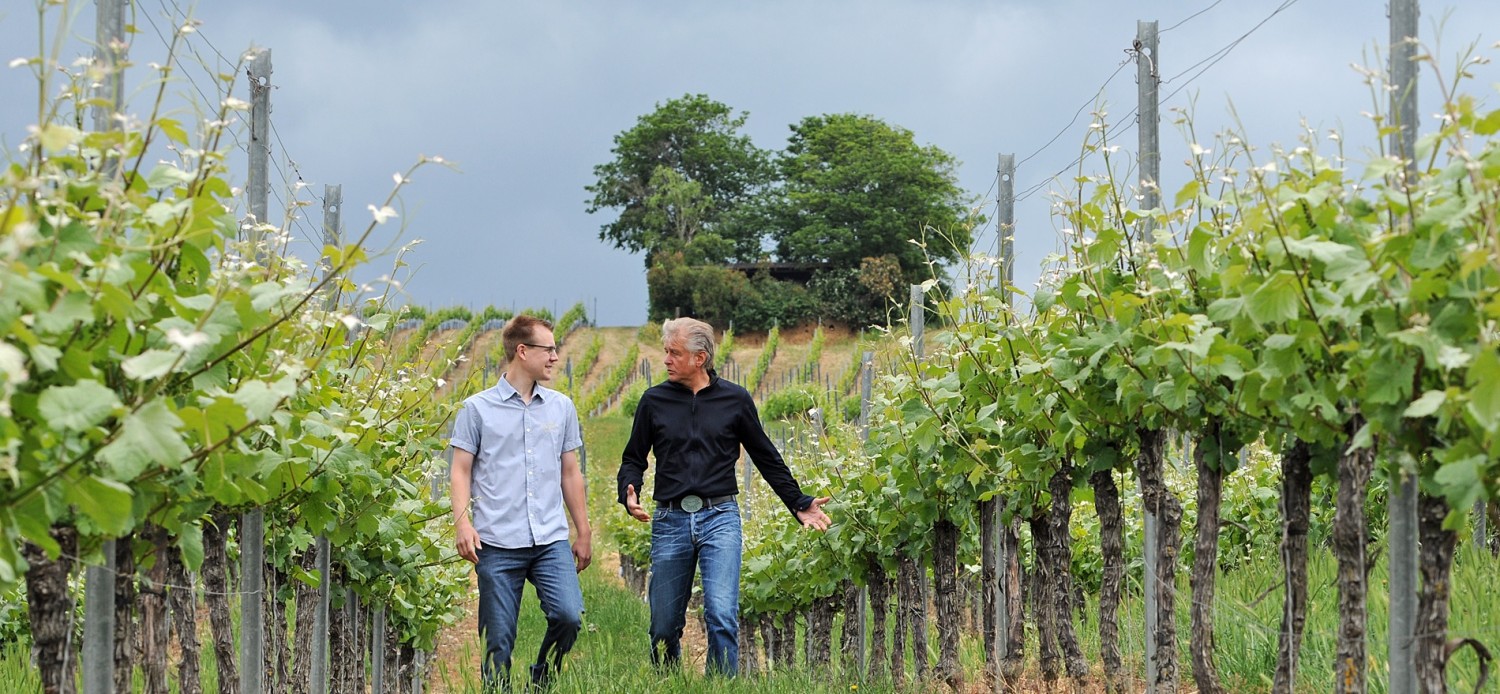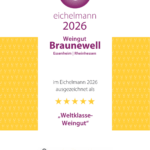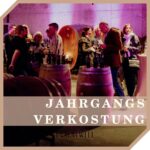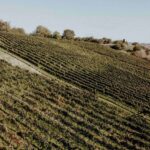By Simon Field MW
March 12, 2020
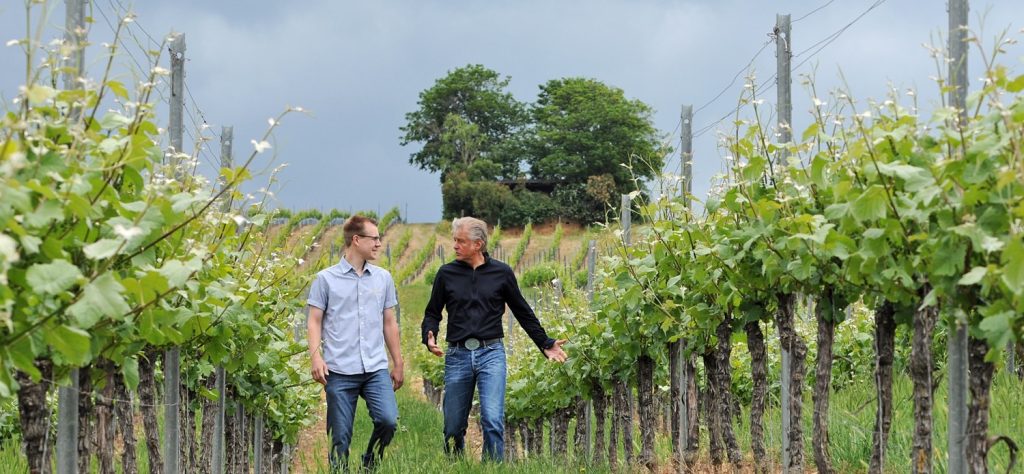
Although still somewhat immature as a wine category, German rosé has almost doubled in production over the past decade – up to 12% of all German wine production. Because German Pinot Noir is the third highest planting of the variety worldwide we can expect to see a lot more of German rosé, writes Simon Field MW, especially with so many quality winemakers making both high-end and commercial, populist styles. On a press trip entitled Think Pink! Field was introduced to a plethora of wines that showed many of the issues facing German rosé – most notably name and style – as it strives to forge its own identity in this fascinating category.
We encountered many different opinions on whether German rosé should be made in the cellar, are single varieties showing a sense of place or are reflections of the winemaker.
Eins Zwei Dry… was I dreaming or was this indeed the name of the best-selling line by Leitz?… from Johannes Leitz, of all people, one of the great champions of traditional values, and now high priest of the very select brotherhood of the Verband Deutsche Prädikatsweingüter (VDP).
The small winery in the backstreets of Rüdesheim that I recall from way back when is no more, or at least not showcased to visitors; now we are ushered into a shining megalopolis next to the highway, tanks everywhere. ‘Do you have a Leitz Light?’ I asked, only half joking. We are working on it. Oh, and there is now an Eins Zwei Dry Rosé too. That’s why we are here.
There is an unchallengeable logic to the mission to develop the category; rosé wine is soaring throughout the world. Look at Provence. Climate change is warming the Teutonic heart, and, lest we forget, Pinot Noir (aka Spätburgunder) in Germany represents the third highest planting of the varietal in the world.
16 journalists and experts were invited from 16 countries to celebrate this fact and, at the culmination of a trip punctuated by nine winery visits, were treated to a grand tasting at the Deutsches Weininstitut (DWI) at Bodenheim, where an already shortened list of 50 Sekts and still rosé wines was to be narrowed down to 20 to be shown on stand at ProWein, where the plan was for the list to be shortened yet further to reveal a top three podium of rosé excellence.
A fantastic idea and a wonderful way to showcase the best in class from a young and, some may say, somewhat immature category. Rosé now represents 12% of production in Germany, up from 7% a decade ago. Its most expensive example, the excellent Braunewell I Dinter der Rosé Trocken, sells for a relatively modest Є25 at the cellar door; somewhat less than the top wines from Esclans and Miraval it seems.
First, this being Germany, we were treated to a couple of hours of facts and stats, not a great deal of which, it seemed to me, were focused on pink wine. Key points from the miasma of information is that the German vineyards cover 102,000 hectares, which is less than Bordeaux and that, although there are 10,000 growers, the pressure is increasing to sell into the bigger houses (or to turn into a bigger house, as with Leitz , see above) and to sell more generic wines (see above once again).
70% of the world’s Riesling is planted here and yet there is also a move in the direction of all things Pinot; ‘Pinot Paradise’, as Steffen Schindler from the DWI described it, breaking away for a moment from the sea of statistics of his presentation. Blauburgunder, Spätburgunder, Grauburgunder… they are all on the rise, taking over, not surprisingly but only very gradually, from Müller-Thurgau, Silvaner and the like.
How German rosé is caught in the middle of a ‘game of two halves’
A wealth of facts ensures, one of the most striking concerning production; Germany produces 9 million hl, but drinks an impressive 20 million; its exports are thus fairly modest at 3.5 million, and it imports over 14 million. That’s a lot of wine. A sellers’ market, right?
Well, yes and no, and this is where the canard of quality versus quantity, legislation vs simplicity of message creeps in. The juxtaposition of a qualitative system which defers to sucrosity (i.e. QbA and QmP) with one which has place as its cynosure (VDP with Grosses Gewächs as its Grand Cru) is hard to reconcile. Time and time again on the trip growers were suggesting that nomenclature such as Trocken Spätlese was inherently unhelpful. Keep the QmP for sweet wines only; and do not in any way impede the progress of the Trocken category.
Do not, however, undermine by dilution the reputation of the VDP system. This makes sense, but it does mean that if fewer and fewer growers are going down the sugar route, and if the VDP is capped at 250 producers, then there is a large hinterland of wineries and wines which do not fall into either camp. In limbo.
Which is where we find a lot of the rosé. It is not syllogistic to deduce that there may well, therefore, be a temptation to go down a more commercial route. Indeed, in the brief part of Steffen’s presentation devoted to pink wine the message was clear; this is a product which should cater generally to a youthful market, its summery message unencumbered by gothic gravitas and the weight of historical struggle. Think Pink! Brand Cool! And so forth.
The problem here, clearly, is that we were visiting some very serious producers, several of them members of the VDP; and instinctively they lured us, having quickly shown the rosé wines, to the more serious ‘top end’ of their ranges. There is quite a distance from the Leitz Eins Zwei Drei Rosé to the superlative Leitz Rüdesheimer Berg Rottland Goldkapsule Riesling Alte Reben Trocken. It can only be thus, the question is whether or not the two can thrive in a manner that is mutually beneficial to producer and market alike. Provence doesn’t really have the crippling luxury of such a problem.
Drilling down into the ‘problem’ one lands on two key issues: nomenclature and style.
In terms of name the decision to use the Francophone word ‘rosé’ has been taken deliberately, albeit reluctantly, the potential alternatives such a Weißherbst or Schiller not really working on an international market. A shame, but perfectly understandable.
In terms of style, there are more pressing issues of forging an identity, somewhat paradoxical given the apparent primacy of Spätburgunder. During the tasting I was struck, with still and sparkling wines alike, by the varieties of colour, by a tendency to make wines that were either reduced or oxidised with the hallowed middle ground seldom trod, and most of all by the levels of residual sugar, which I often found to be intrusive, clearly battling with putative stylistic integrity. A very large number of wines had RS levels in double figures, which one seldom finds in the South of France these days. A distinct identity is impossible to locate.
Think Pink! a press tour ‘In the Name of the Rosé’
But quibbles aside; there were some excellent wines and some terrific visits on our Think Pink! press trip. To boot we were lucky enough to be accompanied by Angelina Vogt, the sogennant German Wine Queen (Deutsche Weinkönigin) complete with a golden crown adorned with thirteen golden grapes, one for each wine region. A walking anachronism for our guide into the heart of the Palatinate.
And I have to say that I did not realise that, between them, Rheinhessen and the Pfalz cover over half the surface area of German vineyards (51k hectares), but with only 3,000 in Rheingau itself. The trip traversed the feudal heart of the Holy Roman Empire, looping from the pink sandstone of Mainz to the frosty hinterland on the French border, then back to cross the Rhine and to Geisenheim and finally Wiesbaden.
Everyone was friendly, many wore the travails of Brexit as an almost personal loss, with genuine humility. There is healthy tourism here, mostly from within Germany, and an incredible amount of wine sold at the cellar door. Many of the wineries wore the historical architecture of a proud heritage, Neus in Ingelheim and Weingut Janson Bernhard in Zellertal especially. The latter treated us to a candlelit diner in a gabled ‘stable’, biblical in its simplicity, with the menus written in hand and the main course (‘pink pig chops on a beetroot risotto base’) touchingly faithful to the ‘Think Pink’ brief and perfectly matched to the 2018 Kalkfels Rosé.
Elsewhere we met the enigmatic Christoph Hammel, his long beard and trilby recalling an Amish refugee from ZZ Top, his forearm heavily tattooed with the date of the founding of his winery (1723); the bickering father-and-son team at Jean Buscher, where the son Jean Raphael attempted to stick to the rosé brief, but the father, Jean Michael, victorious, led us to the cellar, where there was no rosé in sight, to taste a superlative Spätburgunder from 2005 and a Riesling from 1959, fresh and powerful.
Elsewhere we visited the dynamic Co-op at Wachtenburg Winzer, where it was interesting to taste differing styles of rosé, the saignée version unusually powerful and gastronomically friendly. Then there was the celebrated VDP Knipser based in Laumersheim; their rosés were very good indeed, with an impressive stylistic distinction between the 2019 Clarette Rosé (Bordeaux blend but pale) and the 2017 Rosé Fumé (also a Bordeaux blend but darker and partially made by the saignée technique) ..and as for their 2015 Kirschgarten Spätburgunder GG, well that was a red wine, so the superlatives had better await another article.
Braunewell: a great winery to start and to finish
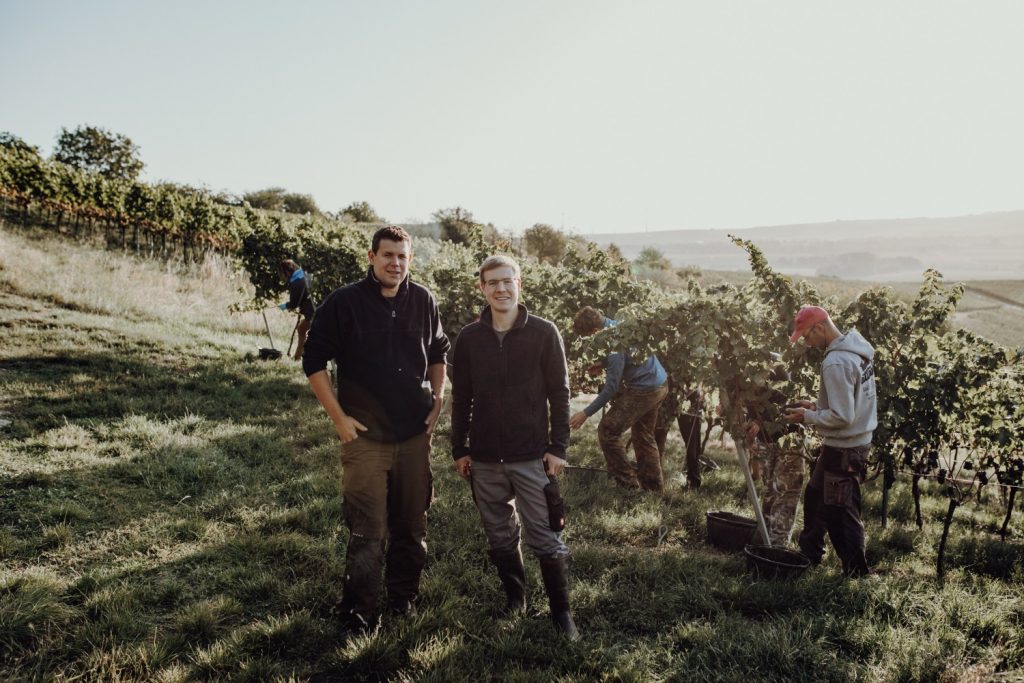
Finally, or initially, as he was the first visit, the winemaker who it seems to be was the most committed to the rosé project, Stefan Braunewell. A good place to start then.
Farming 28 hectares around Essenheim, he divides his vineyards equally between Riesling, Spätburgunder and the fashionable Grauburgunder, and makes five different rosés, of which two are sparkling. The still wines run the stylistic gamut from the entry Summer Rosé, via the fuller bodied Im Namen des Rosé (hopefully he has patented the name!) to the serious Braunewell I Dinter der Rosé, the ‘expensive’ wine as mentioned above.
His sugar levels are kept relatively low, with the wines made in large wood mainly, so not oaky, and aged extensively on lees, which, allied to a full malolactic fermentation, ensures a charming creamy style. We were treated to a vertical of this line from 2014 to 2018, with vintage variation impressive in the name of the qualitative imperative. To me this was an essential Germanic rosé; minerals and herbs poised in a harmonious juxtaposition with delicate red fruit; subtle and charming, long and food friendly. A touch more austere than its Provencal cousins, but engaging and poised. If only they were all like this.

A conclusion which has no conclusions
There are many different voices, many different styles. Werner Knipser is adamant that ‘rosé wines are producer wines; it is hard to even contemplate regional identity… “rosé is made in the cellar and there should be more faith in blending different varieties”, yet Stefan Braunewell is of the opinion that the single varietal is king, and that there can be a real sense of place emanating from the pink wines. But then Christoph Hammel counters in an inimitable fashion; “I am not a terroir kind of guy… it’s all down to the winemaker.” And so on.
So where does that leave us? With some interesting wines and many gifted producers, for sure, with a variety of styles, increasingly homing in on Spätburgunder but also with rather a lot of work to be done. Work that surely will repay the effort over time.
